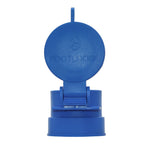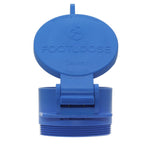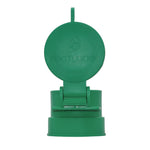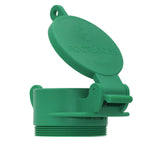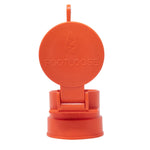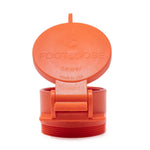You have no items in your shopping cart.
You’ve seen them on public streets and sidewalks without thinking twice about their purpose. But those of us who have joined the world of pipelines see manhole coverings as the entranceways to public services that also keep the general public safe.
A manhole is an opening to an enclosed space, such as a shaft or utility vault, often found on city streets and sidewalks. Manhole depths can vary—some are fairly shallow, while others extend more than 50 feet underground. These are access points to public utilities such as sewer systems and storm drains that lie underground. They allow authorized parties access to clean, inspect, and rehabilitate these systems as needed.
A manhole cover is a removable plate that acts as a lid to the manhole’s opening. These heavy coverings prevent unauthorized individuals and materials from falling into the access point. If you need to open a manhole, follow our practical guide on how to remove a manhole cover safely.
When and Why Is It Okay to Open a Manhole?
Since manholes provide access to public sewer systems and other underground facilities, they are typically only accessed when inspectors and other authorized professionals must conduct necessary repairs, maintenance, cleaning, or routine inspections of the systems housed underground.
Before opening or accessing a manhole, authorized individuals should follow a few important steps:
- Obtain Permission – All operators and maintenance professionals must receive proper authorization to open a manhole. A permit is required in some situations.
- Secure the Area – Secure the area with cones and barriers to keep pedestrians and workers safe from injury once the covering has been removed.
- Have the Right Tools – Be sure to have all the necessary manhole cover remover tools before starting.
- Apply Safe Work Practices – Because manhole covers differ in design, you and your team should prepare ahead of time and have a plan in place before starting any part of the process.
What Is a Manhole Key?
A manhole key, also referred to as a manhole hook, is designed to safely lift and remove a manhole cover. These keys are inserted into the keyway of the covering, which is a slot or opening that is perfectly shaped to fit this key. Most manhole covers have two keyways, so keys are often sold in pairs to accommodate this.
Manhole keys come in various shapes and sizes, so it’s imperative to have the right key for the cover you are looking to remove. There are two other manhole cover remover tools you may find useful to help open a manhole safely:
- Pick or Crowbar – This multi-task tool has a point on one end and a flat, horizontal claw on the other.
- Flat Screwdriver – A long flathead screwdriver can be used with the help of a hammer with a long handle and straight claw.
Because some manhole covers don’t have any keyholes built into them, you will need to insert a pick or screwdriver into the grooved slot around the rim to safely pry open the manhole cover. Always know what type of cover you will be removing before heading to the job site.
How to Open a Manhole
Since covers typically weigh anywhere from 90 to 150 pounds, they can be too heavy for a single person to safely lift alone. It is always advised to have more than one person present when removing a manhole cover or opening a storm drain covering. Here’s how to lift a manhole cover properly:
- Insert the Key – Insert the key into the manhole cover’s keyhole and turn a quarter of the way to lock it into place. This will allow you to safely lift the covering.
- Lift Vertically – With the help of another person, lift the covering vertically and safely lay it down flat on the ground next to the opening.
- Be Careful – Exercise extra caution when moving the manhole cover so it doesn’t accidentally drop or slide back into the hole.

Tips and Tricks for Opening a Manhole Safely
Because manholes differ in design, some may require more thought and preparation to ensure you have the right tools at the ready.
- Loosen the Cover – In situations where the cover needs to be loosened first, strike it with a sledgehammer or mallet.
- Clean the Lid – When the manhole lid is covered in debris or ice, use water or a blower to clean around the ring first.
- Stand Opposite of the Keyhole – Stand on the opposite side of the covering’s keyhole to leverage the hook to safely pry open the lid.
- Lift with Your Legs – Straighten your back and bend your knees slightly while using the hook as a lever to pop open the covering. Use your legs to push down and pry up the lid to lift the manhole cover.
- Watch Your Hands and Feet – Never place your fingers or feet under the lid.
- Use a Block – Insert a block between the lid and rim and pull the lid toward yourself and away from the opening. Prop the lid on the block wherever you’re keeping it so it’s easier to replace the lid later.
Potential Dangers to Avoid
Occasionally, a manhole cover will be more difficult than usual to open or require being open for an extended period. Working around these open manholes will require strict communication and safety measures. Here are a few potential dangers to be aware of when working with manhole coverings:
- Breaking the Lid – Sometimes, the cover can get stuck in its ring, and removal measures with a sledgehammer can cause it to break—a costly and dangerous situation.
- Using Your Hands for Removal – No matter the circumstances, contractors should never use their hands when removing manhole lids.
- Trip or Fall Hazards – Once the covering has been removed, place a safety barrier around the open manhole and the lid to avoid trips and falls.

Importance of Safety and the Dangers of Manholes
No matter what tool or removal method you use to open a manhole, safety should always be the number one priority.
- Watch Your Back – Even the most experienced industrial water and wastewater treatment professionals can injure their back when working with heavy coverings.
- Wear Gloves – Covers are often rough and rusty, and some have sharp edges. Heavy-duty gloves are always advised.
- Training and Awareness – Manhole safety should always be taken very seriously.
It’s important to remember that while incorporating these suggestions can lower potential risks posed by manholes and their coverings, there is no substitute for proper preparation, training, and awareness of



